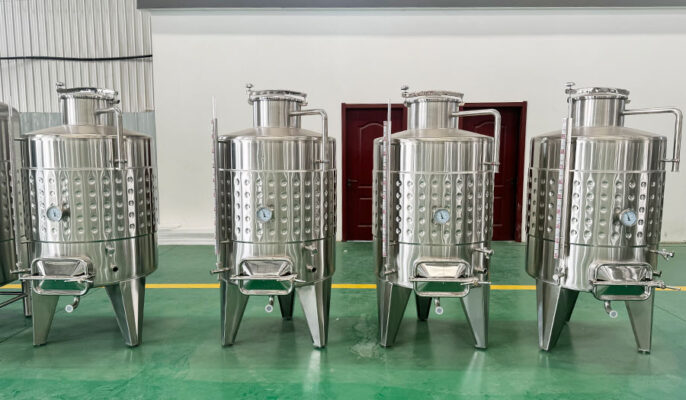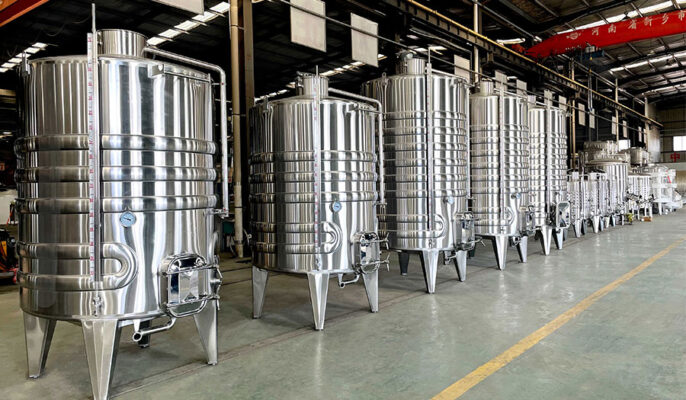Выдержка вина в ферментерах из нержавеющей стали - это надежный и эффективный способ сохранить свежесть вина, обеспечивая при этом точный контроль температуры. Ферментаторы для вина из нержавеющей стали являются ключевым оборудованием в современной винодельческой промышленности. В этом руководстве вы найдете исчерпывающий обзор всех аспектов работы винных ферментеров из нержавеющей стали, что поможет вам лучше понять их устройство.
Что такое вино бродильный чан? И как это работает?
Емкость для брожения вина - это емкость, используемая для брожения виноградного сока при изготовлении вина. Брожение - это превращение сахара в виноградном соке в спирт и углекислый газ. Конструкция и материалы емкости для брожения вина напрямую влияют на эффект процесса брожения и качество вина. Многие емкости для брожения оснащены системами контроля температуры для поддержания подходящей температуры брожения и оптимизации активности дрожжей. Слишком высокая или слишком низкая температура может повлиять на эффективность процесса брожения и вкус вина.
Основные этапы ферментации включают первичную и вторичную ферментацию. Первичное брожение обычно длится от 7 до 10 дней, в то время как вторичное брожение может продолжаться месяцами и даже годами. Виноделы должны точно контролировать температуру, время и другие условия брожения, чтобы обеспечить качество конечного вина.

Виды нержавеющей стали резервуары для брожения вина
Цилиндрические емкости для брожения
Наиболее распространенная форма резервуара для брожения обычно используется на крупных коммерческих винодельческих предприятиях. Цилиндрическая конструкция помогает равномерно перемешивать виноградный сок и дрожжи, а также эффективно справляется с газом, образующимся в процессе брожения. Подходит для производства любого размера, особенно для средних и крупных виноделен.
Овальный резервуар для брожения
По сравнению с цилиндрической формой, дно овального бродильного резервуара относительно плоское, что позволяет уменьшить воздействие осадков, образующихся в процессе брожения, на корпус резервуара. Подходит для винодельческих процессов, в которых необходимо уменьшить вмешательство осадка.
Емкость для брожения с регулируемой температурой
- Емкость для брожения с охлаждающей рубашкой: оснащена внешней охлаждающей рубашкой для контроля температуры в процессе брожения путем охлаждения жидкости. Он может обеспечить эффективный контроль температуры во время высокотемпературной ферментации. Подходит для винодельческих процессов, требующих контроля высоких температур, особенно при производстве в условиях теплого климата.
- Емкость для брожения с нагревательной рубашкой: оснащена нагревательным устройством для поддержания подходящей температуры брожения в условиях низкой температуры. Регулировка температуры осуществляется с помощью нагревательной рубашки или системы электрообогрева. Он подходит для процессов ферментации в холодной среде, чтобы обеспечить активность и эффективность брожения дрожжей.
Многофункциональный резервуар для брожения
- Емкость для брожения с перемешиванием: встроенное устройство для перемешивания, которое позволяет поддерживать однородность виноградного сока во время брожения и способствует перемешиванию и активности дрожжей. Подходит для винодельческих процессов, требующих частого перемешивания, например, для брожения некоторых красных вин.
- Самоочищающиеся ферментационные емкости: Оснащены автоматическими системами очистки, такими как форсунки или щеточные устройства, для упрощения процесса очистки и дезинфекции. Подходят для производственных помещений с высокими требованиями к гигиене, сокращая ручной труд по очистке.
|
ТИП ТАНКОВ |
ОПИСАНИЕ |
ИДЕАЛЬНОЕ РЕШЕНИЕ ДЛЯ |
|
Резервуары с плоским дном |
Самая простая конструкция, имеющая плоское дно и вертикальный цилиндрический корпус. |
Универсален для различных стилей ферментации. |
|
Резервуары с рубашкой |
Эти резервуары имеют двойные стенки, позволяющие регулировать температуру с помощью циркулирующей охлаждающей жидкости или нагревательного агента. |
Ферментация красного вина, где регулирование температуры имеет решающее значение. |
|
Резервуары с коническим дном |
Эти резервуары имеют конусообразное дно, способствующее оседанию виноградных шкурок и осадков во время ферментации. |
Ферментация красного вина, способствующая эффективной экстракции цвета и танинов. |
|
Резервуары переменной емкости |
Эти инновационные резервуары оснащены внутренней плавающей крышкой, которая регулируется в зависимости от объема вина, сводя к минимуму образование свободного пространства и окисление. |
Мелкосерийное виноделие или ситуации, когда объем брожения варьируется. |
|
Напорные резервуары |
Эти резервуары, рассчитанные на более высокое давление, идеально подходят для производства игристых вин по методу Charmat. |
Производство игристых вин. |

Преимущества и недостатки нержавеющей стали Емкости для брожения вина
Преимущества
- Устойчивость к коррозии: Одним из главных преимуществ нержавеющей стали является ее превосходная коррозионная стойкость. Виноградный сок содержит множество кислых компонентов, которые могут вызвать коррозию оборудования. По сравнению с деревянными бочками или другими материалами, резервуары из нержавеющей стали лучше противостоят этой коррозии и обеспечивают стабильность и безопасность при длительном использовании.
- Легко чистить и дезинфицировать: Процесс брожения вина требует чрезвычайно высоких гигиенических стандартов. Гладкая поверхность резервуара из нержавеющей стали облегчает процесс очистки и дезинфекции и делает его более тщательным. Большинство резервуаров для брожения из нержавеющей стали оснащены системой очистки, что делает процесс очистки более эффективным и автоматизированным.
- Возможность контроля температуры: Температура является одним из ключевых факторов, влияющих на процесс ферментации. Поскольку нержавеющая сталь обладает хорошей теплопроводностью, контроль температуры может осуществляться более эффективно. Многие современные резервуары для брожения из нержавеющей стали оснащены системами контроля температуры, включая нагревательные и охлаждающие устройства, чтобы обеспечить поддержание температуры брожения в идеальном диапазоне, тем самым оптимизируя эффект брожения алкоголя.
- Стабильная структура: Нержавеющая сталь обладает высокой прочностью и устойчивостью к давлению и может выдерживать давление, возникающее в процессе брожения. Это снижает риск утечки или повреждения оборудования и обеспечивает безопасность и стабильность процесса виноделия.
- Без запаха: Нержавеющая сталь не вступает в химическую реакцию с виноградным соком, поэтому она не влияет на аромат вина. Деревянные бочки, напротив, могут передавать свои ароматы вину, влияя на его вкус и аромат.
Недостатки
- Стоимость: резервуары из нержавеющей стали требуют значительных инвестиций по сравнению с некоторыми альтернативными материалами, такими как бетон или дерево.
- Изоляция: Нержавеющая сталь не сохраняет тепло так же хорошо, как бетон, что является недостатком для метода холодного вымачивания, используемого в некоторых винных производствах.
- Возможность появления металлических запахов: При неправильном уходе или использовании с определенными сортами винограда существует небольшой риск появления металлических запахов в вине.
Структура резервуара для брожения вина из нержавеющей стали
Конструкция резервуара
Конструкция резервуаров для брожения из нержавеющей стали обычно включает в себя корпус резервуара, крышку резервуара, выхлопной патрубок, патрубок подачи и систему контроля температуры. Корпус резервуара обычно имеет цилиндрическую или эллиптическую форму, чтобы уменьшить площадь контакта между жидкостью и воздухом во время брожения и снизить риск окисления.
Крышка резервуара и система уплотнения
Конструкция крышки резервуара должна обеспечивать эффективную герметизацию корпуса резервуара, чтобы предотвратить попадание наружного воздуха. Современные резервуары для брожения из нержавеющей стали обычно оснащены устройствами для герметизации и выпускными клапанами, чтобы справляться с газами, образующимися в процессе брожения.
Выхлопная система
В процессе брожения образуется большое количество углекислого газа, который необходимо эффективно выводить через вытяжную систему. Современные резервуары для брожения из нержавеющей стали обычно оснащаются автоматическими системами отвода газов, чтобы обеспечить плавный отвод газов и избежать воздействия избыточного давления на корпус резервуара.
Система контроля температуры
Емкости для брожения из нержавеющей стали обычно оснащены встроенными системами контроля температуры, включая охлаждающие рубашки и нагревательные устройства. Охлаждающая рубашка обычно изготавливается из нержавеющей стали и обеспечивает охлаждение корпуса емкости, а нагревательное устройство используется для регулирования процесса брожения в условиях низких температур.
Система перемешивания и откачки
Многие бродильные емкости оснащены системами перемешивания для равномерного перемешивания бродильной жидкости и обеспечения равномерного контакта между дрожжами и виноградным соком. Кроме того, для подачи виноградного сока в бродильную емкость или из нее используется насосная система, обеспечивающая эффективную и удобную работу.
Как выбрать резервуар для брожения вина?
Правильный выбор емкости для брожения вина - это ключ к обеспечению высокого качества продукции.
Определите масштаб производства.
Если вы являетесь любителем домашнего вина или небольшим производителем, вы можете выбрать небольшую или микроферментационную емкость. Объем небольшой емкости для брожения обычно составляет от нескольких литров до сотен литров, что подходит для мелкосерийного производства. Для средних и крупных винодельческих предприятий необходимо выбрать бродильный резервуар большой вместимости, объем которого может составлять от тысячи литров до десятков тысяч литров. Большой бродильные ёмкости может обрабатывать большие партии виноградного сока.
Выбор материала
- Нержавеющая сталь: Большинство современных виноделен выбирают емкости для брожения из нержавеющей стали, поскольку она устойчива к коррозии, легко чистится и позволяет поддерживать стабильную среду для брожения. Материал резервуара из нержавеющей стали также позволяет сохранить чистый аромат вина, не оказывая негативного влияния на его структуру.
- Дерево: деревянные бочки до сих пор используются в некоторых винных производствах, особенно в тех, где требуется древесный аромат и сложность. Выбор деревянных бочек влияет на вкус вина, поэтому их нужно выбирать в соответствии с потребностями вина.
- Пластик и стекло: Эти материалы подходят для мелкосерийного или экспериментального производства. Пластиковые емкости для брожения легки и экономичны, но легко подвергаются воздействию окружающей среды; стеклянные емкости обычно используются в лабораторных условиях или при производстве небольших партий продукции.
Требования к температурному контролю
- Система контроля температуры: Контроль температуры во время ферментации очень важен. Выбирайте ферментер, оснащенный эффективной системой контроля температуры (включая функции охлаждения и нагрева), чтобы ферментация проходила при идеальной температуре.
- Охлаждающая рубашка: используется в теплом климате или в процессах ферментации, требующих точного контроля низких температур.
- Нагревательная рубашка: поддерживает подходящую температуру брожения в холодном помещении.
Требования к процессу ферментации
Для процессов брожения, требующих частого перемешивания (например, брожение красного вина), выбирайте ферментер, оснащенный устройством для перемешивания, которое поможет равномерно перемешать виноградный сок и дрожжи. Эффективная вытяжная система справится с углекислым газом, образующимся в процессе брожения, и предотвратит чрезмерное давление в емкости.
Бюджет и стоимость
Цена ферментера варьируется от нескольких тысяч до сотен тысяч, в зависимости от материала, функций и вместимости. Убедитесь, что выбранный вами ферментер соответствует вашему бюджету и отвечает вашим производственным потребностям. Помимо первоначальной стоимости, необходимо также учитывать долговечность оборудования и затраты на его обслуживание. Высококачественные ферментеры из нержавеющей стали обычно демонстрируют высокую экономическую эффективность при длительном использовании.
Обслуживание поставщиков
Выбирайте поставщика с хорошей репутацией и послужным списком, чтобы гарантировать качество оборудования и послепродажного обслуживания. Узнайте о послепродажном обслуживании, предоставляемом поставщиком, включая ремонт, техническое обслуживание и техническую поддержку. Конечно, вы также можете обратиться в Micet Group, наши профессиональные инженеры разработают подходящий для вас резервуар для брожения вина из нержавеющей стали.
ЧАСТО ЗАДАВАЕМЫЕ ВОПРОСЫ
Что такое резервуар для брожения вина из нержавеющей стали?
Бак для брожения вина из нержавеющей стали - это емкость для брожения виноградного сока, изготовленная из нержавеющей стали. Ее преимущества - коррозионная стойкость, простота очистки и стабильный температурный контроль. Основная функция бродильного резервуара - поддерживать дрожжи для преобразования сахара в виноградном соке в спирт и углекислый газ.
Как обслуживать и чистить бродильную емкость из нержавеющей стали?
Регулярная очистка Используйте моющее средство и воду для регулярной очистки резервуара от грязи и остатков. Если бродильный бак оснащен автоматической системой очистки, очищайте его в соответствии с инструкциями по эксплуатации, предоставленными поставщиком. Перед и после каждого использования проводите надлежащую дезинфекцию, чтобы избежать микробного заражения.
Каков срок службы резервуара для брожения из нержавеющей стали?
Срок службы резервуара для брожения из нержавеющей стали зависит от технического обслуживания, частоты использования и условий окружающей среды. В целом, высококачественный бак для брожения из нержавеющей стали, который хорошо обслуживается и правильно используется, может прослужить много лет. Регулярный осмотр и техническое обслуживание помогут продлить срок службы оборудования.
На какие подводные камни следует обратить внимание при выборе емкости для брожения из нержавеющей стали?
Убедитесь, что функции и конфигурация бродильного резервуара соответствуют реальным производственным потребностям, и избегайте приобретения ненужных функций. Низкая цена не обязательно означает высокую производительность. Выбор оборудования известных брендов и высококачественных материалов может обеспечить долгосрочную стабильность. Выбирайте поставщика с хорошим послепродажным обслуживанием, чтобы обеспечить техническую поддержку и обслуживание в течение всего срока эксплуатации оборудования.




